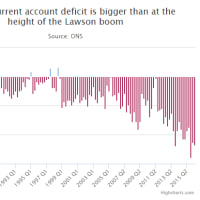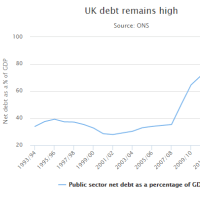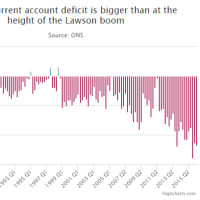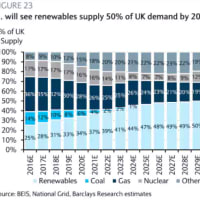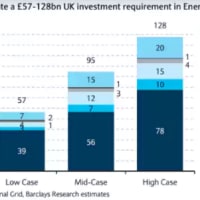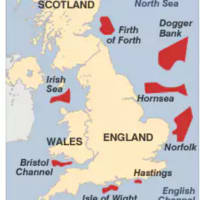久々になんとなくだらだら訳してみましたが、そりゃあなた、甚だしい勘違いです。
ポルポポ政権が政治的変化と構造改革の可能性を提示している、って、日本支社の連中に電話して確認してから書いたんですか???
まあ、やる気のなさと絶望感は世界一だと思いますけど。
地下鉄の中などはゾンビだらけで、正視出来ない状況です。
こういうことは、バフェット氏が乗り込んできてから書いて下さいよ。
Japan on track for Warren Buffett-style flutter
(日本:ウォレン・バフェット式に張ってみますか)
By Tom Stevenson
Telegraph:07 Nov 2009

ポルポポ政権が政治的変化と構造改革の可能性を提示している、って、日本支社の連中に電話して確認してから書いたんですか???
まあ、やる気のなさと絶望感は世界一だと思いますけど。
地下鉄の中などはゾンビだらけで、正視出来ない状況です。
こういうことは、バフェット氏が乗り込んできてから書いて下さいよ。
Japan on track for Warren Buffett-style flutter
(日本:ウォレン・バフェット式に張ってみますか)
By Tom Stevenson
Telegraph:07 Nov 2009
Warren Buffett's $44bn purchase of the Burlington Northern Santa Fe railway is a classic Berkshire Hathaway acquisition.
ウォレン・バフェットがバーリントン・ノーザン・サンタフェ鉄道を440億ドルで買収した。これは古典的なバークシャー・ハサウェイ式買収である。
On the face of it a big but unexciting deal, it gets better and better the more you think about it ? contrarian investing at its finest.
一見すると大規模だが地味な取引だが、考えれば考えるほど良いものに思える。
最高の逆張りだ。
The conventional wisdom, especially in America, is that railways are yesterday's story, a relic from the days before Eisenhower's interstates criss-crossed the country in the 1950s to confirm the victory of the car and truck. The deal defies a second piece of 'crowd-think' too - that America is doomed to play second fiddle to the explosive growth of the world's emerging markets. As Buffett conceded, this is an "all-in wager" on America's future.
常識、特に米国の常識では、鉄道など過去の遺物であり、1950年代にアイゼンハウアーの州間高速道路が全米を縦横無尽に走り、自動車とトラックの勝利宣言を行う前の時代の思い出である。
また鉄道会社の買収は、米国は世界の新興市場の爆発的成長の脇役を務めるしかない、という2つ目の『常識』も否定している。
バフェットが認めた通り、これは米国の未来に対する「全力をかけた賭け」なのだ。
Buffett's reputation as the world's most successful investor hangs on his ability to buy a good business when most other investors dislike or are at best indifferent to it. When he bought General Foods and Coca-Cola in the 1980s, Wall Street could think of little good to say about either purchase. General Foods was seen as a no-growth food manufacturer while Coke was just a safe, conservative, but pretty unattractive, portfolio staple.
世界最高の投資家というバフェットの評判は、殆どの投資家がこれを嫌っている、又は無視している時に優良企業を買う、という彼の能力によるものだ。
バフェットが1980年代にジェネラルフーズやコカコーラを買った時、ウォール街はどちらも余り評価しなかった。
ジェネラルフーズは成長の見込みのない食品メーカー、コカコーラは保守的な安全牌だがつまらない安定銘柄だと思われていた。
However, after Buffett bought shares in General Foods, its earnings grew rapidly as commodity deflation reduced costs while consumer spending increased. By the time he sold out to Philip Morris in 1985, Buffett's investment had tripled. In the first 10 years after he bought Coca-Cola, its shares rose more than eight-fold.
しかし、バフェットがジェネラルフーズの株を買った後、商品デフレで原価が下がり消費者支出が増加すると、その売上は急成長した。
1985年にフィリップモリスに売却する頃までに、バフェットの投資は3倍になっていた。
コカコーラを買ってから最初の10年間に、同社の株価は8倍に上がった。
The acquisition of Burlington Northern could be just such a piece of contrarian lateral thinking. Buffett's gamble is that the railways will be seen as a low-cost, environmentally-friendly alternative to the roads if the oil price continues its upward trend. It is, therefore, not so much a bet against emerging growth as a sideways play on it.
バーリントン・ノーザンの買収も、同じような逆張り投資家的思考なのかもしれない。
バフェットは、石油価格の上昇トレンドが継続した場合、鉄道は自動車よりも低コストでエコな代替輸送手段と見なされるだろう、という目に賭けたのだ。
But the real attraction to Buffett of a deal like this is that the market's pervasive pessimism means he can pick up the company for a song. He is buying a business with a near-impregnable market position (no-one's going to build a rival rail network in the western US) for around nine times operating profits. Buffett can not only afford to wait, he can even afford to be a bit wrong - the ultimate margin of safety.
しかし、バフェットにとってこのような取引が本当に魅力的だったのは、市場が悲観だらけの時は二束三文でこのような会社が買えるということだ。
彼は殆ど難攻不落のポジションにある会社を、営業利益の約9倍で買っている(誰も米国西部にライバル鉄道網を作ろうなどとはしない)。
バフェットは待つことが出来るだけでなく、多少の誤差も許容することが出来るのである。
究極のセーフティ・マージンだ。
Buffett has become one of the world's richest men by looking the other way from the rest of the crowd, but it's something every investor can do if they can avoid the easy temptation to go with the herd.
バフェットは人と違う方向に目を向けることで、世界で最も裕福な人物の仲間入りをしたが、この方法は、他者に続くという安易な誘惑を避けることが出来れば、どの投資家にも可能なことだ。
We've been here before. In February 2000, the technology stock bubble was reaching its mad climax, Vodafone had just overpaid for Mannesmann and investors were stampeding to buy shares in loss-making lastminute.com ? the high-water float of the internet boom. Amid all this madness, you could have bought shares in Whitbread for 446p, a price that represented about seven times the company's expected earnings.
前にもあった。2000年2月、ドットコム・バブルがピークで弾けた。
ボーダフォンはマンネスマンに高過ぎる代金を払ったところだった。
投資家は、ドットコム・バブルの野心的上場を果たした、赤字経営会社lastminute.comの株を買い捲っていた。
この狂気の真っ只中、ウィトブレッドは業績予想の約7倍の446ペンスで買うことが出来ただろう。
At that price, its dividend would have given you an income of 6.5pc. The book value of the company's assets (which then comprised an unfashionable collection of brewing, pubs, hotel and health club businesses) was 750p, half as much again as the share price.
その価格なら、配当率は6.5%である。
同社の資産(当時は時代遅れな醸造、パブ、ホテル、ヘルスクラブといった事業で構成されていた)の帳簿価格は750ペンス。
これも株価の半分だった。
This was classic Buffett territory and, perhaps unsurprisingly, the outcome for a contrarian investor was Buffett-style rewards. For the first three years, a period during which the FTSE 100 fell by almost 40pc, the shares moved sideways. Then they really took off as investors regained their appetite for the stock market. By the time they peaked in April 2007, Whitbread shares had risen to more than £19. Even today, after a two-year roller-coaster, an investor who has reinvested their dividends throughout the past 10 years has tripled their money. Even with the benefit of re-invested dividends, the market as a whole has gone nowhere over the same period.
これこそ古典的なバフェット銘柄だ。
そして、恐らく驚くまでもないことだが、バフェット式逆張り投資家的な結果も出ている。
最初の3年間、FTSE100は40%近く下落したが、同社の株は横這いだった。
その後、投資家が株式市場への投資意欲を取り戻すと、本格的に上昇し始めた。
2007年4月のピークまでに、ウィトブレッド株は19ポンドを超えるまでに値上がりした。
今日、2年間のローラーコースター状態の末ですら、過去10年間配当を再投資した投資家は元手を3倍に増やしている。
再投資された配当の利益を以ってしても、市場全体は同期間に結果を出せていない。
So, given that Buffett has already picked up Burlington Northern, where should you look for counter-intuitive bargains today? My first stop is always to see what investors are not buying by looking at the fund flows at the website of the Investment Management Association.
というわけで、バフェットが既にバーリントン・ノーザンを買ったことを考慮すると、目下の逆張りバーゲンはどこを探すべきだろうか。
私は常に、IMAのサイトでファンドの資金の流れを確認して、投資家が買っていない所を真っ先に見に行く。
No surprises there. The biggest net outflows in September were once again from funds invested in Japan - the country that liked the lost decade so much it decided to repeat it. The Nikkei index, at around 10,000, still stands about 75pc lower than it did 20 years ago, when it peaked just below 39,000. Predicting an end to the slow strangulation of the Japanese stock market has been a mug's game for nearly a generation.
驚くまでもない。
9月に最も資金が流出したのは、またまた、日本投資ファンドであった。
この国は失われた十年を愛し過ぎるが故に、これを繰り返すことを決断したのである。
日経平均は10,000ほどで、未だに39,000を僅かに切れるあたりでピークを迎えた20年前よりも、75%も安いままだ。
日本の株式市場が真綿で首を絞められるのが終わるのはいつか?
これを予測することは、非常に長い期間、馬鹿げた遊びだった。
The numbers don't lie, but the almost total lack of interest in what remains a stable and prosperous economy, the world's second largest, is a good sign for Buffett-esque contrarians. With a new government offering the prospect of political change and structural reform, a unique position as a back-yard exporter to the world's fastest-growing region and share prices which have finally shaken off the overvaluation that made them so unattractive two decades ago, perhaps Japan is the Burlington Northern of the East.
数字は嘘を吐かないが、今も安定する豊かな経済、世界第2位の経済大国へのほぼ完全な関心の欠落は、バフェット式逆張りには良いサインだ。
新政権は政治的変化と構造改革の可能性を提供している。
世界最速成長中の地域の身近な輸出業者、というユニークな立場がある。
株価は遂に、20年前に自ら魅力を失うこととなった、過剰評価をふるい落とした。
というわけで、日本は極東のバーリントン・ノーザンなのかもしれない。
Tom Stevenson is an investment commentator at Fidelity International. The ideas expressed are his own.











